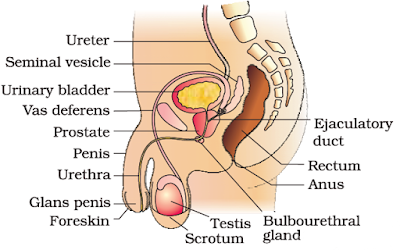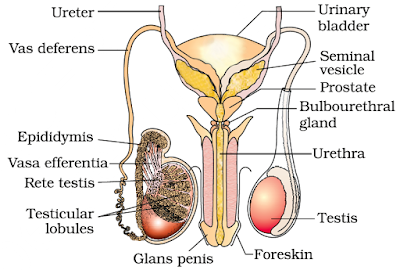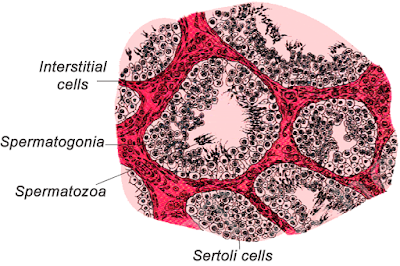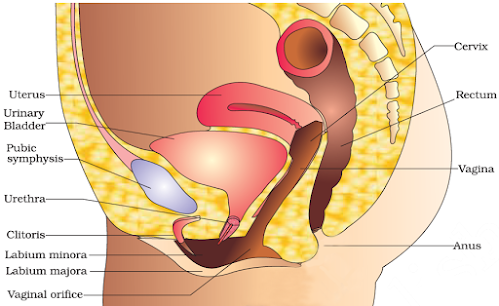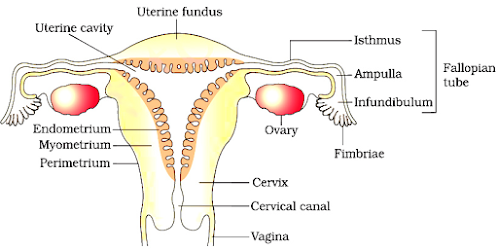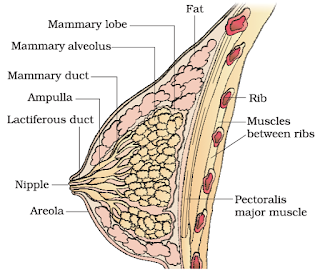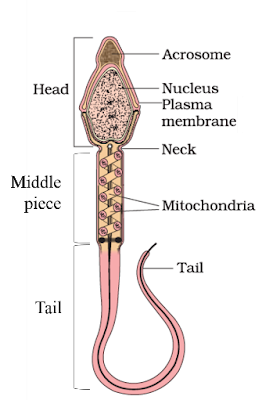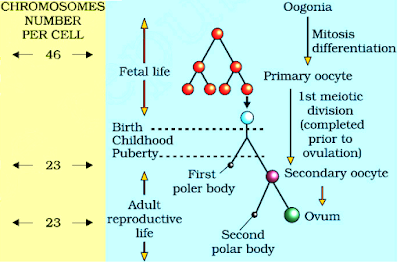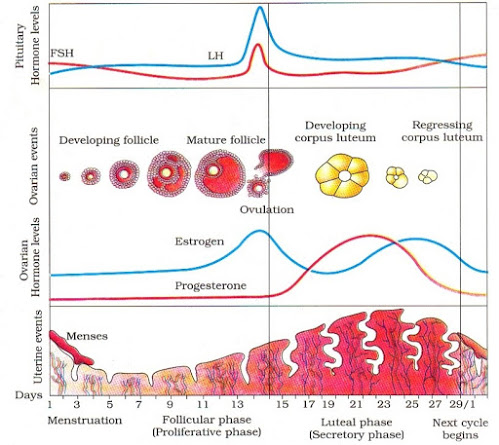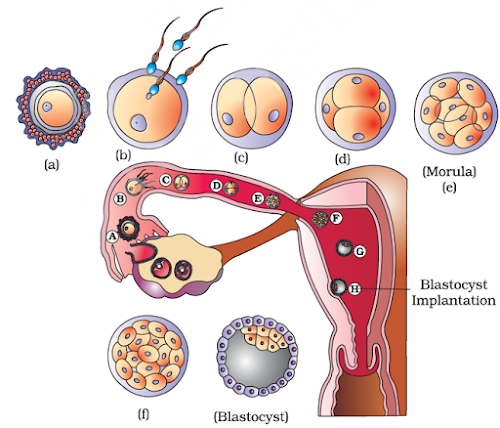Human Reproduction : Notes and Study Materials -pdf
Notes and Study Materials
- Concepts of Human Reproduction
- Master File Human Reproduction
- NCERT Book chapter Human Reproduction
- NCERT Solutions for – Human Reproduction
- NCERT Exemplar Solutions for – Human Reproduction
- Revision Note of Human Reproduction
- Past Many Years Question papers and Answer of Human Reproduction
- Mind Map of Human Reproduction
Examples and Exercise
1. Male Reproductive System
– It consists of paired testes, Accessory ducts, Accessory glands & external genitalia (penis).
a. Paired testes
– Primary sex organs that produce sperms & testosterone.
– Testes are formed within the abdomen. Soon after the birth or at the 8th month of pregnancy they descent into the scrotal sac (scrotum) through inguinal canal.
– The low temperature (2-2.50 C less than the body temperature) of scrotum helps for proper functioning of testes and for spermatogenesis.
– Each testis is oval shaped. Length 4-5 cm, width: 2-3 cm.
– Each testis has about 250 testicular lobules.
– Each lobule contains 1-3 coiled seminiferous tubules.
– Seminiferous tubule is lined internally with
· Male germ cells (spermatogonia): They become sperms.
· Sertoli cells: They give nutrition to the germs cells.
– The regions outside the seminiferous tubules (interstitial spaces) contain small blood vessels, interstitial cells (Leydig cells) and immunologically competent cells.
– Leydig cells secrete testicular hormones (androgens).
b. Accessory ducts (Duct system)
– Include rete testis, vasa efferentia, epididymis & vas deferens. They conduct sperms from testis as follows:
– Seminiferous tubules → rete testis (irregular cavities) → vasa efferentia (series of fine tubules) → epididymis (stores sperms temporarily) → vas deferens → join with duct of seminal vesicle to form ejaculatory duct → urethra → urethral meatus.
– Urethra receives ducts of prostate and Cowper’s glands.
c. Accessory glands
– Include a prostate gland, a pair of seminal vesicles and a pair of Cowper’s glands (bulbo-urethral glands).
– Their collective secretion (seminal plasma) is rich in fructose, Ca and enzymes.
– Seminal plasma + sperms → semen.
– Functions of seminal plasma:
· Helps for transporting sperms.
· Supplies nutrients to sperms.
· Provides alkalinity to counteract the acidity of uterus.
· Secretions of Cowper’s glands lubricate the penis.
– Secretions of epididymis, vas deferens, seminal vesicle & prostate help for maturation and motility of sperms.
d. Penis (external genitalia)
– It is a copulatory organ made of erectile spongy tissue.
– When spongy tissue is filled with blood, the penis erects. It facilitates insemination.
– The cone-shaped tip of the penis is called glans penis. It is covered by prepuce (foreskin).
2. Female Reproductive System
It is located in the pelvic region.
It includes Ovaries, Accessory ducts & External genitalia.
a. Paired ovaries
– Primary sex organs which produce ova (female gamete) & steroid ovarian hormones (estrogen & progesterone).
– Each ovary is 2-4 cm in length.
– They are located on both side of the lower abdomen and connected to the pelvic wall and uterus by ligaments.
– Each ovary is covered by a thin epithelium which encloses the ovarian stroma.
– The stroma has outer cortex and inner medulla.
– Ovarian cortex contains groups of cells (Ovarian follicles). Each follicle carries a centrally placed ovum.
b. Accessory ducts (Duct system)
Include 2 oviducts (Fallopian tubes), a uterus & vagina.
Ø Oviducts: Each oviduct (10-12 cm long) has 3 parts:
· Infundibulum: Funnel-shaped opening provided with many finger-like fimbriae. It helps to collect the ovum.
· Ampulla: Wider part.
· Isthmus: Narrow part. It joins the uterus.
The ciliated epithelium lined the lumen of the oviduct drives the ovum towards the uterus.
Ø Uterus (womb): It is inverted pear shaped. It is supported by ligaments attached to the pelvic wall.
Uterus has 3 parts: Upper fundus, middle body and terminal cervix. Cervix opens to vagina.
Cervical canal and vagina forms birth canal.
The uterine wall has 3 layers:
· Perimetrium: External thin membrane.
· Myometrium: Middle thick layer of smooth muscle.
· Endometrium: Inner glandular and vascular layer.
Ø Vagina: It opens to the exterior between urethra & anus.
c. External genitalia (vulva or pudendum)
– Consist of Mons pubis, labia majora, labia minora, hymen & clitoris.
– Mons pubis: A cushion of fatty tissue covered by pubic hair.
– Labia majora: Large, fleshy, fatty and hairy outer folds. Surrounds vaginal opening.
– Labia minora: Small, thin and hairless inner folds.
– Hymen (Maiden head): A membrane which partially cover the vaginal opening. It is often torn during the first coitus. It may also be broken by a sudden fall or jolt, insertion of a vaginal tampon; active participation in some sports items etc. In some women, hymen persists after coitus. So the hymen is not a reliable indicator of virginity or sexual experience.
– Clitoris: A highly sensitive organ lying just in front of the urethral opening.
Mammary glands (breasts)
– A pair of mammary glands contains glandular tissue & fat.
– Glandular tissue of each breast has 15-20 mammary lobes containing clusters of cells (mammary alveoli).
– Cells of alveoli secrete milk. It is stored in lumen of alveoli.
– The alveoli open into mammary tubules.
– The tubules of each lobe join to form a mammary duct.
– Several mammary ducts join to form a wider mammary ampulla which is connected to lactiferous duct through which milk is sucked out.
GAMETOGENESIS
– It is the formation of gametes in the gonads.
– It is 2 types: Spermatogenesis and Oogenesis.
1. Spermatogenesis
It is the process of formation of sperms (spermatozoa) in seminiferous tubules of testis. It has 2 stages:
a. Formation of spermatids: In this, Sperm mother cells (Spermatogonia or male germ cells) produce spermatids.
b. Spermiogenesis: Spermatids transform into sperm.
Schematic representation of spermatogenesis
– 4 spermatids are formed from each primary spermatocyte.
– After spermiogenesis, sperm heads are embedded in Sertoli cells to get nourishment. Then they are released to lumen of seminiferous tubules. It is called spermiation.
Diagrammatic sectional view of a seminiferous tubule
Role of Hormones in Spermatogenesis
– Hypothalamus releases Gonadotropin releasing hormone (GnRH).
– GnRH stimulates the anterior pituitary gland to secrete 2 gonadotropins such as Luteinizing hormone (LH) and
follicle stimulating hormone (FSH).
– LH acts on the Leydig cells and stimulates secretion of androgens. Androgens stimulate the spermatogenesis.
– FSH acts on the Sertoli cells and stimulates secretion of some factors for the spermiogenesis.
Structure of spermatozoa (Sperm)
– A mature sperm is about 60 µ (0.06 mm) long.
– A plasma membrane envelops the whole body of sperm.
– A sperm has 3 regions:
a. Head: Oval shaped. Formed of nucleus and acrosome. Acrosome is formed from Golgi complex. It contains lytic enzymes. Behind the head is a neck.
b. Middle piece: Composed of axial filament surrounded by mitochondria & cytoplasm. Mitochondria produce energy for the sperm motility.
c. Tail: Consists of a central axial filament. The sperm moves in fluid medium and female genital tract by the undulating movement of the tail.
– Man ejaculates 200-300 million sperms during a coitus.
– For normal fertility, at least 60% sperms must have normal shape and size. 40% of them must show vigorous motility.
2. Oogenesis
– It is the process of formation and maturation of ovum.
– It takes place in Ovarian follicles.
– Oogenesis is initiated in embryonic stage when 2 million of egg mother cells (oogonia) are formed within each ovary.
– No more oogonia are formed and added after birth.
– Oogonia multiply to form primary oocytes. They enter prophase-I of the meiosis and get temporarily arrested at that stage.
– Each primary oocyte gets surrounded by a layer of granulosa cells to form primary follicle.
– Many primary follicles degenerate during the phase from birth to puberty. Therefore, at puberty, only 60,000-80,000 primary follicles are left in each ovary.
– Primary follicles get surrounded by more layers of granulosa cells and a new theca to form secondary follicles.
– The secondary follicles transform into a tertiary follicle. It has a fluid filled cavity (antrum). The theca layer forms an inner theca interna and an outer theca externa.
– The primary oocyte in tertiary follicle grows and undergoes first unequal meiotic division to form a large secondary oocyte (n) & a tiny first polar body (n). So, secondary oocyte retains nutrient rich cytoplasm of primary oocyte.
– It is unknown that whether the first polar body divides further or degenerates.
– The tertiary follicle further changes into the mature follicle (Graafian follicle).
– Secondary oocyte forms a new membrane (zona pellucida).
– Graafian follicle now ruptures to release the secondary oocyte (ovum) from the ovary. This is called ovulation.
Schematic representation of oogenesis
Structure of ovum (egg)
– Spherical and non-motile. About 0.2 mm in diameter.
– Ovum has 3 membranes:
a. Plasma membrane: Innermost layer.
b. Zona pellucida: Outer to the plasma membrane.
c. Corona radiata: Outer layer formed of follicle cells.
Spermatogenesis & Oogenesis- A comparison
Spermatogenesis
Oogenesis
Occurs in testis.
Occurs in ovary.
Limited growth phase.
Elaborated growth phase
Each primary spermatocyte gives 4 sperms.
Each primary oocyte gives one ovum.
No polar body formation.
Polar bodies are formed.
Begins at puberty and extends up to senility.
Begins at embryonic stage but suspends up to puberty. It ceases around the age of fifty.
MENSTRUAL CYCLE (REPRODUCTIVE CYCLE)
– It is the cyclic events in female reproductive system starting from one menstruation till the next during the reproductive period (from puberty to menopause).
– Its duration is 28 or 29 days.
– Menstrual cycle is also seen in other primates.
– Menstrual cycle includes Ovarian cycle (changes in ovary) & Uterine cycle (changes in uterus, oviduct & vagina).
– Menstrual cycle has the following phases:
I. Menstrual phase: 1-5th day
– The cycle starts with menstrual flow (bleeding).
– It lasts for 3-5 days.
– Menstruation occurs if the released ovum is not fertilized. It results in breakdown of endometrial lining and its blood vessels that comes out through vagina.
– Lack of menstruation indicates pregnancy. It may also be caused due to stress, poor health etc.
– Menarche: The first menstruation during puberty.
II. Follicular (Proliferative) phase: 5-13th day
– It starts from 5th day after menstruation and completed within 8-12 days.
– In this phase, the action of gonadotropins (FSH &LH) from pituitary occurs. FSH stimulates
o Development of primary follicles into Graafian follicles.
o Secretion of oestrogens by Graafian follicles.
– Oestrogens stimulate
o Proliferation of ruptured uterine endometrium and mucus lining of oviduct & vagina.
o Development of secondary sexual characters.
o Suppression of FSH secretion.
o Secretion of LH (Luteinizing hormone).
III. Ovulatory phase: 14th day
– LH & FSH attain a peak level in the middle of cycle.
– Rapid secretion of LH (LH surge) induces rupture of Graafian follicle and thereby ovulation (on 14th day).
IV. Secretory (Luteal) phase: 15-28th day
– After ovulation, Graafian follicle is transformed to a yellow
endocrine mass called Corpus luteum. It secretes progesterone.
– Functions of progesterone:
o Makes the endometrium maximum vascular, thick and soft. Thus, the uterus gets ready for implantation.
o Inhibits the FSH secretion to prevent development of a second ovarian follicle.
– If fertilization does not occur, corpus luteum degenerates. It causes disintegration of endometrium. It leads to next menstruation and new cycle.
– If a woman becomes pregnant, all events of menstrual cycle stop and there is no menstruation.
– Menstrual cycle ceases around 50 years of age. It is called Menopause.
Menstrual hygiene:
· Take bath and clean body regularly.
· Use sanitary napkins or clean homemade pads.
· Change them after every 4 – 5 hrs as per the requirement.
· Dispose the used napkins or pads properly. Do not throw them in the drainpipe of toilets or in the open area.
· After handling the napkin, wash hands with soap.
FERTILIZATION AND IMPLANTATION
– During copulation, semen is released by the penis into the vagina. It is called insemination.
– Fusion of a sperm with ovum is called fertilization. It occurs in Ampullary region of fallopian tube.
Sperms → vagina → cervical canal → uterus → isthmus
↓
Fertilization ← Ampullary region
↑
Ovum (from ovary) → fimbriae → infundibulum
– Fertilization happens only if ovum & sperms are transported simultaneously. So all copulations do not lead to fertilization & pregnancy.
– A sperm contacts with zona pellucida. It induces changes in the membrane that block entry of additional sperms.
– The secretions of the acrosome help sperm to enter the egg cytoplasm via zona pellucida & plasma membrane. This causes second meiotic division of secondary oocyte to form an ovum (ootid) and a second polar body.
– The haploid nuclei of the sperm and ovum fuse together to form a diploid zygote.
– Zygote undergoes mitotic division (cleavage) as it moves through the isthmus towards the uterus and forms 2, 4, 8, 16 daughter cells called blastomeres.
– The embryo with 8-16 blastomeres is called a morula.
– Morula continues to divide and transforms into blastocyst.
– In blastocyst, blastomeres are arranged into trophoblast (outer layer) and an inner cell mass attached to trophoblast.
– The trophoblast layer gives nourishment to inner cell mass. Also, it gets attached to endometrium.
– After attachment, uterine cells divide rapidly and cover the blastocyst. Thus, the blastocyst becomes embedded in the endometrium. This is called implantation.
– The inner cell mass gets differentiated to 3 germ layers (outer ectoderm, middle mesoderm & inner endoderm). This 3-layered structure (gastrula) forms the embryo.
PREGNANCY AND EMBRYONIC DEVELOPMENT
– After implantation, finger-like projections (chorionic villi) appear on the trophoblast.
– They are surrounded by uterine tissue and maternal blood.
– The chorionic villi & uterine tissue are interdigitated to form placenta. It is a structural and functional unit b/w embryo (foetus) and maternal body.
– Placenta is connected to the embryo by an umbilical cord. It transports substances to and from the embryo.
Functions of placenta
· Acts as barrier between the foetus and mother.
· Supply O2, nutrients etc. from mother to foetus.
· Remove CO2 and excretory wastes from foetus.
· Acts as an endocrine gland. It secretes Human chorionic gonadotropin (hCG), human placental lactogen (hPL), oestrogens, progesterone & relaxin. Relaxin is also secreted by ovary.
– During pregnancy, levels of estrogens, progestogens, cortisol, prolactin, thyroxin etc. are also increased in maternal blood. They support the fetal growth, metabolic changes in the mother and maintain pregnancy.
– The germ layers give rise to all tissues (organs). The stem cells in inner cell mass have the potency to give rise to all the tissues and organs.
– Human pregnancy (gestation period) lasts 9 months (cats: 2 months, dogs: 2 months, elephants: 21 months).
Changes in embryo during pregnancy
· After one month: Heart is formed.
· End of second month: Limbs and digits are developed.
· End of 12 weeks (first trimester): Major organs (limbs, external genital organs etc.) are well developed.
· During 5th month: First movement of foetus and appearance of hair on the head.
· End of 24 weeks (end of 2nd trimester): Body is covered with fine hair, eyelids separate and eye lashes are formed.
· End of 9 months: Ready for delivery.
PARTURITION AND LACTATION
– Parturition (labour): Process of giving birth to young ones.
– Parturition is induced by neuroendocrine mechanism.
– The signals originating from the foetus and placenta induce mild uterine contractions (fetal ejection reflex). This causes the release of oxytocin from maternal pituitary.
– Oxytocin causes stronger uterine muscle contractions which in turn stimulate further secretion of oxytocin. This process is continued leading to expulsion of the baby out of the uterus through the birth canal.
– After parturition, the umbilical cord is cut off.
– The placenta & remnants of umbilical cord are expelled from the maternal body after parturition. It is called “after birth”.
– The mammary glands produce milk towards the end of pregnancy. It is called lactation.
– The yellowish milk produced during the initial few days of lactation is called colostrum. It contains several antibodies essential to develop resistance for the new born babies.
CBSE Class 12th Biology Notes: Human Reproduction
The weightage for the Bio chapter 3, Human Reproduction, in the board exam is 12 marks. Each definitions and concept is followed by the solved and unsolved questions. You can also find the various categories questions like short, very short and long answer type.
Have a look on the Highlights of important terminologies and questions :
Very Short Answer Type Question (1-Mark)
Q. 1. Given below are the events in human reproduction. Write them in correct sequential order. Insemination, gemetogenesis, fertilisation, parturition, gestation, implanation.
Ans. Gametogenesis, insemination, fertilization, implantation, gestation, parturition
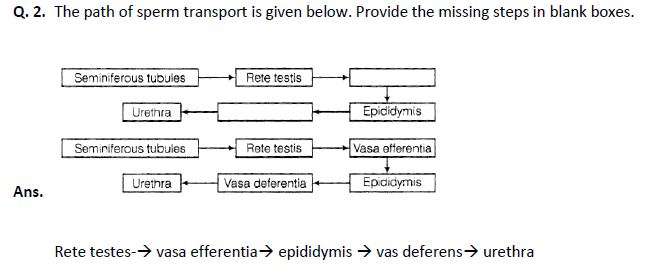
Q. 3. At what stage of life is oogenesis initiated in a human male? When does the oocyte complete oogenesis?
Ans. At after the Puberty stage of life is oogenesis initiated in human female. When oocyte change in to Graafian follicle. The process off oogenesis is complete.
Q. 4. Name the two type of gametogenesis.
Ans. (i) Spermatogenesis in Males (Human).
(ii) Oogenesis in female (Human).
Q. 5. What are fertiligin molecules.
Ans. There are glycoproteinous molecules. Which name a number of spermophillicsites on their surface and bind a number of sperms by fertilizing-antifertilizin reaction.
Q. 6. Name the three Primary germ layers.
Ans. (i) Endoderm
(ii) Ectoderm
(iii) Mesoderm.
Q. 7. What are major components of seminal plasma.
Ans. Seminal fluid is the secretion of accessory sex glands of male i.e. of seminal vesicles, prostate gland and Cowper’s glands. It is rich in fructose, calcium and certain enzyme.
Q. 8. How many eggs do you think were released by the ovary of a female dog which gave birth to 6 puppies.
Ans. The ovaries of a female dog must have released 6 eggs, each of which gets fertilized and so six zygotes are formed, each of which develops in to a puppy.
Short Answer Type Question (2-Mark)
Q. 1. How is the foetus with Rh positive blood affected if the mother is Rh?
Ans. This disorder pertains to compatibility of blood group and Rh factor, Rh is a protein (antigen) in RBCs of 85% of people (Ru+). They are called Rh+ and other who lack it are Rh-. Rh factor was first discovered in Rhesus monkey marriage between Rh- woman and Rh+ man result in Rh+ foetus. It causes the formation of antibodies against the Rh actor in the development of child. First pregnancy is usually without problem but the subsequent pregenancy proves to be fatal for the child because of the antibodies already present in mother. Antibodies damage haemoglobin and brain of the child, this result in Erythroblastosis foetalis.
Q. 2. Name any one enzyme that coagulates milk protein in a human adult. Mention the sources and site of action of that enzyme and the products formed.
Ans. Enzyme that coagulates milk is rennin. It is secreted by gastric–gland of mucous membrane of the stomach of human beings. If acts in the stomach and coagulates the mile i.e., converts casein to caseinogens (insoluble protein).
Q. 3. What forms the corpus luteum? Name the hormones secreted by it.
Ans. Egg cell (ovum) of human female after maturation gets covered by a thick layer of yellow lipids (fats). It is called corpus leutum. It secretes the progesterone this progravid phase prepares itself for implantation.
Q. 4. What structure forms the ‘corpus luteum’ and at what stage? Name two hormones secreted by it.
Ans. On the 15th day of onset of menstrual cycle, a matter red ovum (egg cell) is released. Ovum covered by a number of layer and a yellow fat layer forms corpus leutum. It releases (secretes) progesterone.
Q. 5. Draw the diagrammatic section of seminiferous tubules with levels.
Ans.
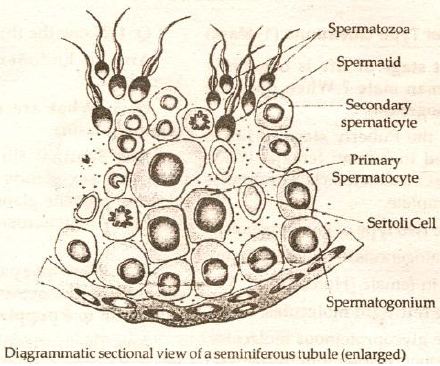
Q. 6. Draw the sectional view of female pelvis with levels.
Ans.

Short Answer Type Question (3-Mark)
Q. 1. Draw the labeled diagramme of foetus within uterus?
Ans.
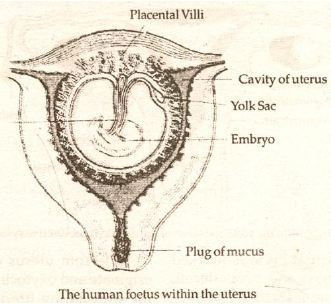
Q. 2. Draw a labeled diagramme of the microscopic structure of a human sperm?
Ans.
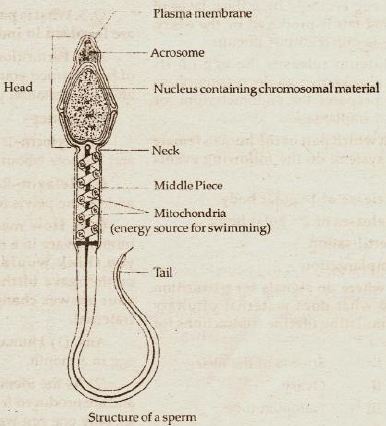
Q. 3. Why is second half menstrual cycle called secretary phase in human female. List the changes that occur in uterus during the phase.
Ans.
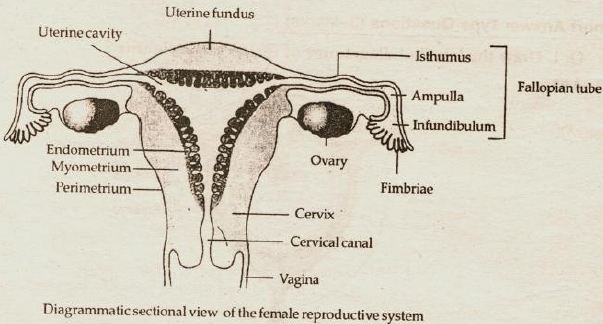
Second half of menstrual cycle is marked by the secretion of estrogen and progesteron, hence called secretory phase. During secretory phase which is under the control of progesterone and estrogen, egg enclosed by a thick layer of yellow coloured fats in producted by the ovary. This structure is called corpus luteum. Corpus luteum releases the egg on its rupture. It is also known as Regressing-phase as this phase prepares the endometerium for pregnancy and implantation.
Q. 4. (a) In which part of the human female reproductive system, do the following events take place?
I – Release of 1st polar body.
II – Releases of 2nd polar body.
III – Fertilisation
IV – Implantation
(b) From where do signals for parturition originate and what does maternal pituitary release for stimulating uterine contractions for child birth?
Ans. (a) I – Stroma of the ovary
II – Ovary
III – Fallopian tube
IV – Implantation.
(b) From uterus do signals for parturition originate and oxytocin maternal pituitary release for stimulating uterine contractions for child birth.
Q. 5. What is parturition? Which hormones are involved in induction of parturition.
Ans. Parturition is the process of expelling of fully formed young from the mother’s uterus after the gestation period.
Hormones-
Oxytocin- It stimulates forceful of uterus and induces labour pain.
Relaxin- Relaxin of corpus albicaus widens the pelvis for easy child birth.
Q. 6. How many eggs are released by a human ovary in a month ? How many eggs do you think would have been released the mother gave birth to identical twins, would your answer change if the twins born were fraternal.
Ans. Human ovary produces only one egg in a month. As the identical Twins are monozygotic and are produced from two parts of same zygote so, only one egg was released from the ovary. As the fraternal twins are dizygotic and are produced from two different zygotes which is possible only if two eggs are released from the ovaries in a months.
Q. 7. In our Society the women are often blamed for giving birth to daughters, canny u explain why this is not correct.
Ans. It is not correct to blame the woman for giving birth to daughters because a female homogametic sex and produces only one type of eggs, each having 22 autosomes and one X chromosomes. On the other hands, a male is a heterogamety ex as produces two type of sperms that is 50% with X chromosome and 50% with Y chromonsomes, the sex of baby depends upon the type of sperm fusing with the eggs, so sex of baby is determined by father and not mother.
Short Answer Type Question (5-Mark)
Q. 1. (a) when and where does spermatogenesis in a human begin to take place.
(b) With the help of schematic labeled diagrams trace the development of mature spermatozoa in human male.
(c) Describe the structure of a human sperm.
Ans. (a) In testis, the immature male germ cells (spermatogonia) produce sperms by spermatogenesis that begins at Puberty.

(c)

Q.2. (a) Draw a labeled diagram of a sectional view of human seminiferous tubule.
(b) Differentiate between gametogenesis in human males and females on the basis of
(i) time of initiation of the process.
(ii) products formed at the end of the process.
Ans. (a)

(b)
Spermatogenesis:- | Oogenesis:- |
1. It takes place in the seminiferous tubules of the tested by the repeated division of spermatogonia in male. 2. Spermatogenesis starts at the age of puberty due to significant increases in the secretion of gonadotropin releasing hormone. This is two type luteinizing hormone follicle stimulating hormone. 3. It occurs in four stages spermatogeneisi, Meosis-I, Meosis-II, and spermatogonia. Spermatogenesis involves the maturation of spermatids in to sperms. Primary spermatocytes give rise to four spermatozoa.
| 1. It take place in the Graafian follicles of the ovary by the repeated division of oogonia in the female. 2. Oogenesis is initiated during the embry onic development stage. When a couple ofmilliionn gamete mother cells are formed with in each foetal ovary. 3. It occurs in three stages Oocytogenesis, Meosis-I and Meosis-II Primary oocyte gives rise to one ovum only and three Polar-bodies. Ovum thus formed are non-motile and generally full of food reserves.
|
Q. 3. The events of menstrual cycle are represented below, answer the questions from the following diiagramme.

(i) State thee levels of FSH, LH and Progesterone simply by mentioning high or low, around
13th and 14th day and 21th to 23rd day.
(ii) In which of the above mentioned phases does the egg travel to the fallopian tube?
(iii) Why is there no menstruation upon fertilization?
Ans. (i) In 13th and 14th day LH High and FSH Low. But 21st and 23rd day FSH High and LH Low.
(ii) In proliferative Phase or follicular phase egg travel to the fallopian tube.
(iii) No, Menstruation upon fertilisation. Because when the menstrual cycle stop and there is no menstruation. In absense of fertilisation, the corpus Luteum degenerates and this condition called menopause.
Q. 4. Give a schematic representation of oogenesis in humans. Mention the number of chromosomes at each stage. Correlate the life assesses of the individual with the stages of the process.
Or
Describe Oogenesis in human female.
Ans. (i) It is formation of Ova in the Graffian follicles of ovary and has following phases.
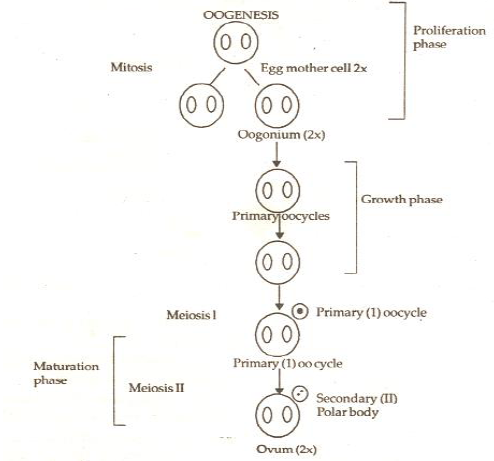
Multiplication phase-The egg mother cell multiplies by mitosis to form oogonia which grow in the follicles.
(ii) Growth phase-In it an oogonium grows in to a large primary oocytes by getting nourishment from follicle cells.
(iii) Maturation phase-It involves meiosis. In meiosis I large haploid oocytes and a small polar body is formed.
Now the follicle ruptures to release secondary oocytes Meiosis II occurs after sperm entry and forms the haploid large ovum and a small polar body. Polar bodies have no function and degenerate.
Q.5
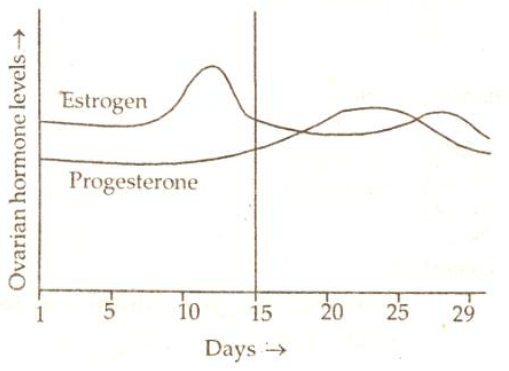
(a) Read the graph given above and correlate the uterine events that take place. according to the hormonal levels on
(1) (i) 6 – 15 days
(ii) 16 – 25 days
(iii) 26 – 28 days (if the ovum is not fertilised)
(2) Specify the sources of the hormones mentioned in the graph.
(b) Describe the structure of ovum fertilisation and passage ‘n fallopian tube.
Ans. (a) (i) Estrogen first increase and then decreases but progesterone almost remains constant.
(ii) In 16 – 25 days progesterone increases but Estrogen-remair s constant.
(iii) In 26 – 28 days, progestron decreases and estrogen increaser.
(b) (i) Secretion of estrogen’ by the growing follicles.
(ii) Corpus Lutem Secretes large amounts of luteum.
(b)
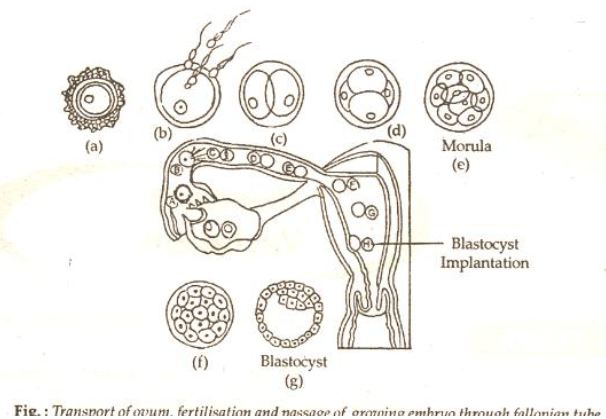
Q. 6. (i) Write the following in expanded forms (a) GnRH (b) FSh
(ii) Difference between Blastulation and gastrulation.
(iii) Mention the function of fallopian tube.Uterus and Vagina.
Ans. (i) GnRh = Gonadotropin Releasing Hormone
Blastulation | Gastrulation |
(a) Rapid mitotic division of zygote (b) Cells do not movement (c) A single-layered hollow blastula is formed | (a) Slow mitotic division (b) Cell masses move from surface of ulastula by morphogenetic (c) 3-layered larva gastrula is formed |
(iii) Fallopian tube: These conduct the ovum towards the Uterus and Ovum may be fertilized by a sperm in it.
Uterus: The fertilized ovum at the blastocyst stage gets implanted on the wall of the Uterus and develops into the growing foetus during pregnancy.
Vagina: It receives the semen from the male during mating. During child birth, it conveys child to the outside.
Human Reproduction Class 12 Biology MCQs
1. Select the correct sequence of stages of spermatogenesis in a human male.
(a) Spermatogonium → Spermatids → Spermatocytes → Spermatozoa
(b) Spermatogonium → Spennatocytes → Spermatids → Spermatozoa
(c) Spermatids → Spermatogonium → Spermatocytes → Spermatozoa
(d) Spermatocytes → Spermatogonium → Spermatids → Spermatozoa
Answer
Answer: b
2. Vas deferens receives the duct of seminal vesicle and forms the
(a) epididymis
(b) urethra
(c) ejaculatory duct
(d) urethral meatus
Answer
Answer: c
3. How many functional sperms and how many ova will be formed by a primary spermatocyte and a primary oocyte, respectively?
(a) One, One
(b) One, Four
(c) Four, One
(d) Four, Four
Answer
Answer: c
4. Proliferative phase of menstrual cycle, is also called
(a) follicular phase
(b) luteal phase
(c) secretory phase
(d) ovulatory phase
Answer
Answer: a
5. Ovulation occurs under the influence of
(a) follicle-stimulating hormone
(b) luteinising hormone
(c) progesterone
(d) estrogen.
Answer
Answer: b
6. There is no cell division involved in
(a) spermatogenesis
(b) oogenesis
(c) embryogenesis
(d) spermiogenesis
Answer
Answer: d
7. It The cell division in secondary oocyte is suspended at
(a) Anaphase II
(b) Metaphase II
(c) Prophase II
(d) Telophase II
Answer
Answer: b
8. After the release of the secondary oocyte, the Graafian follicle develops into
(a) corpus callosum
(b) corpus albicans
(c) corpus luteum
(d) primary follicle
Answer
Answer: c
9. The outermost layer of a blastocyst is called
(a) ectoderm
(b) mesoderm
(c) endoderm
(d) trophoblast
Answer
Answer: d
10. Urethral meatus refers to the [NCERT Exemplar]
(a) urinogenital duct
(b) opening of vas deferens into urethra
(c) external opening of the urinogenital duct
(d) muscles surrounding the urinogenial duct
Answer
Answer: c
11. Morula is a developmental stage [NCERT Exemplar]
(a) between the zygote and blastocyst
(b) between the blastocyst and gastrula
(c) after the implantation
(d) between implantation and parturition
Answer
Answer: a
12. Spermiation is the process of the release of
sperms from [NCERT Exemplar]
(a) seminiferous tubules
(b) vas deferens
(c) epididymis
(d) prostate gland
Answer
Answer: a
13. Which of the following hormones prepares the uterus for implantation?
(a) Progesterone
(b) FSH
(c) Estrogen
(d) LH
Answer
Answer: a
14. The cell which undergoes meiosis I during spermatogenesis, is the
(a) spermatogonium
(b) spermatid
(c) primary spermatocyte
(d) secondary spermatocyte
Answer
Answer: c
15. Seminal plasma, the fluid part of semen is formed by
(a) seminal vesicle and bulbourethral gland.
(b) bulbourethral gland and prostate.
(c) prostate and seminal vesicle.
(d) seminal vesicles, prostate and bulbourethral gland.
Answer
Answer: d
16. The secondary oocyte completes its meiosis II when a sperm comes in contact with it and forms a large cell, the ______ and a second polar body,
Answer/Explanation
Answer:
Explaination: Ootid
17. The gonadotropin-releasing hormone (GnRH) from the _____ initiates spermatogenesis at puberty.
Answer/Explanation
Answer:
Explaination: Hypothalamus
18. The first movements of the foetus and appearance of hair on the head are observed during the _____ month of pregnancy.
Answer/Explanation
Answer:
Explaination: Fifth.
19. The menstrual phase is followed by _____ phase.
Answer/Explanation
Answer:
Explaination: Menarche.
20. _____ refers to the onset of menstruation at puberty.
Answer/Explanation
Answer:
Explaination: Follicular/Proliferative.
21. The outermost thin membranous part of uterine wall is called ______ .
Answer/Explanation
Answer:
Explaination: Menarche.
22. The part of the fallopian tube, which is closer to the ovary and is funnel-shaped, is called ______ .
Answer/Explanation
Answer:
Explaination: Perimetrium.
23. The cells formed as a result of cleavage of the zygote, are called ______ .
Answer/Explanation
Answer:
Explaination: Blastomeres.
24. The placenta is connected to the embryo through _____ .
Answer/Explanation
Answer:
Explaination: Umbilical cord.
25. The process of delivery of the foetus, is called
Answer/Explanation
Answer:
Explaination: Parturition.
Directions (Q26 and Q27): Match Column I with Column II.
26.
| Column I | Column II |
| Cleavage | 1. Outer layer of the blastocyst that attaches to the endometrium during implantation. |
| Implantation | 2. Mitotic divisions of the zygote in quick succession. |
| Inner cell mass | 3. Embedding of the blastocyst in the endometrium of uterus. |
| Troph oblast | 4. Release of secondary oocyte from the ovary. |
| 5. Group of cells attached to one end of trophoblast that differentiate into embryo proper. |
Answer/Explanation
Answer:
Explaination: A – 2, B – 3, C – 5, D – 1
27.
| Column I | Column II |
| A. Acrosome | 1. Motility of sperm towards the egg. |
| B. Head | 2. Powerhouse of the sperm; contains a number of mitochondria. |
| C. Tail | 3. Contains the genetic material. |
| D. Middle piece | 4. Contains enzymes to dissolve egg envelopes |
Answer/Explanation
Answer:
Explaination: A – 4, B – 3, C – 1, D – 2
28. The finger-like projections, called fimbriae, help in the collection of ovum into the fallopian tube following ovulation. [True/False]
Answer/Explanation
Answer:
Explaination: True.
29. Endometrium undergoes cyclical changes and help in uterine movements. [True/False]
Answer/Explanation
Answer:
Explaination: False.
30. Oxytocin, necessary for parturition, is secreted by the fully-developed foetus and the placenta. [True/False]
Answer/Explanation
Answer:
Explaination: False.
31. The finger-like projections that appear on the trophoblast following implantation, are called chorionic villi. [True/False]
Answer/Explanation
Answer:
Explaination: True.
32. Relaxin is the hormone secreted by the placenta. [True/False]
Answer/Explanation
Answer:
Explaination: False.
Directions (Q33 to Q37): Mark the odd one in each of the following groups.
33. Fimbriae, Labia minora, Infundibulum, Isthmus.
Answer/Explanation
Answer:
Explaination: Labia minora
34. Rete testis, Vasa efferentia, Epididymis, Ampulla
Answer/Explanation
Answer:
Explaination: Ampulla
35. Bulbourethral gland, Prostate. Seminal vesicle, Seminiferous tubule.
Answer/Explanation
Answer:
Explaination: Seminiferous tubules
36. Oogonia, Spermatogonia, Zygote, Ootid
Answer/Explanation
Answer:
Explaination: Ootid
37. Luteinizing hormone, Progesterone, Chorionic gonadotropin, Estrogen
Answer/Explanation
Answer:
Explaination: Luteinizing hormone.
38. Name the cells that nourish the germ cells in the testes. Where are these cells located in the testes? [AI2013C]
Answer/Explanation
Answer:
Explaination: Sertoli cells; they are found in the inner lining of seminiferous tubules.
39. How is a primary spennatocyte different from a secondary spermatocyte?
Answer/Explanation
Answer:
Explaination:
– A primary spermatocyte is diploid and has 46 chromosomes; it undergoes meiosis I and forms two secondary spermatocytes.
– A secondary spermatocyte is haploid and has 23 chromosomes; it undergoes meiosis II and forms two spermatids.
40. Where is acrosome present in humans? Write its function. [AI 2012]
Answer/Explanation
Answer:
Explaination:
– Acrosome is present at the anterior end of the head region of a human sperm.
– It contains enzymes that help in dissolving the envelopes (zona pellucida and plasma membrane) of ovum to facilitate entry of sperm into the cyloplasm of the ovum.
41. Why is the middle piece of human sperm considered as ‘powerhouse of the sperm’? [HOTS]
Answer/Explanation
Answer:
Explaination: Middle piece contains numerous mitochondria, which produce energy for the movement of sperm for fertilisation; so it is called the power house.
42. What is semen?
Answer/Explanation
Answer:
Explaination: Seminal plasma (secreted by the male reproductive glands) along with the spermatozoa, constitute semen.
43. Mention the difference between spermiogen- esis and spermiation, [Delhi 2012]
Answer/Explanation
Answer:
Explaination:
– Spermiogenesis is the process of , transformation of spermatids into
flagellated spermatozoa.
– Spermiation is the process of release . of spermatozoa from the seminiferous tubules of the testes into the ducts.
44. How many primary follicles are left in each ovary in a human female at puberty’?
Answer/Explanation
Answer:
Explaination: 60,000 – 80,000 primary follicles are left in each ovary.
45. List the changes the primary oocyte undergoes in the tertiary follicular stage in the human ovary. [Foreign 2011]
Answer/Explanation
Answer:
Explaination: The primary oocyte grows in size and completes meiosis I and forms a larger cell, the secondary oocyte and a smaller cell, the first polar body.
46. Write the physiological reason, why a woman generally cannot conceive a child after 50 years of age. [AI 2013C]
Answer/Explanation
Answer:
Explaination:
– Menopause, i.e. stoppage of menstrual cycles occurs around 50 years of age; since no ovulation occurs, the woman cannot conceive after this age.
47. Not all copulations lead to pregnancy. Give reason. [HOTS]
Answer/Explanation
Answer:
Explaination:
– The sperm and ovum must reach the ampullary-isthmic junction at the same time, if fertilisation has to occur.
– If the sperms and the ovum are not transported simultaneously to the site of fertilisation, no fertilisation occurs, though copulation has occurred.
48. How does the sperm penetrate through the zona pellucida in human ovum? [Delhi 2013C]
Answer/Explanation
Answer:
Explaination: The sperm penetrates through zona pellucida with the help of secretions from its acrosome.
49. How is the entry of only one sperm and not many, ensured into an ovum during fertilisation in humans? [AI 2012]
Or
During fertilization, hundreds of sperm cells are in the vicinity of an egg cell; but only- one sperm enters the ovum. How is this achieved? [HOTS]
Answer/Explanation
Answer:
Explaination: The changes induced in the zona pellucida of the ovum by the sperm coming in contact with it, block the entry of any other sperm and ensures the entry of only one sperm.
50. What is cleavage?
Answer/Explanation
Answer:
Explaination: Cleavage refers to the rapid mitotic divisions that occur in the zygote.
51. Name the embryonic stage that gets implanted in the uterine wall of human female.
Answer/Explanation
Answer:
Explaination: Blastocyst gets implanted.
52. Identify the figure given and the part labelled “A”.[AI 2011]
Answer/Explanation
Answer:
Explaination:
– It is a mammalian blastocyst.
– A is trophoblast.
53. Mention the function of trophoblast in human embryo. [Delhi 2011]
Answer/Explanation
Answer:
Explaination: Trophoblast forms chorionic villi, which become part of the placenta.
54. What are chorionic villi?
Answer/Explanation
Answer:
Explaination: Chorionic villi are the finger-like projections formed by the trophoblast immediately after implantation; they form the foetal part of the placenta.
55. How is the first sign of growing foetus noticed?
Answer/Explanation
Answer:
Explaination: The first sign of growing foetus is noticed by listening to the heart sounds through a stethoscope.
56. What is meant by gestation period?
Answer/Explanation
Answer:
Explaination: The time period between implantation and parturition, when the embryo completes its growth and development, is called gestation period.
57. State where the signals for parturition arise from, in humans. [AI 2017C]
Answer/Explanation
Answer:
Explaination: The signals for parturition arise from the fully-developed foetus and the placenta.
58. What stimulates the pituitary to release the hormone responsible for parturition? Name the hormone. [AI 2011]
Answer/Explanation
Answer:
Explaination:
– The foetal ejection reflex stimulates the release of hormone for parturition.
– Oxytocin is the hormone.
59. Define Lactation.
Answer/Explanation
Answer:
Explaination: Lactation is the process of feeding the new { bom baby with the milk secreted by the mammary glands.
60. How does the sperm penetrate through the zone pellucida in human ovum?
Answer/Explanation
Answer:
Explaination: The sperm penetrates through zona pellucida with the help of the secretions from the acrosome.
Human Reproduction MCQ Chapter 3
Below are some of the very important NCERT Human Reproduction MCQ Class 12 Biology Chapter 3 with Answers. These Human Reproduction MCQ have been prepared by expert teachers and subject experts based on the latest syllabus and pattern of term 1 and term 2. We have given these Human Reproduction MCQ Class 12 Biology Questions with Answers to help students understand the concept.
MCQ Questions for Class 12 Biology Chapter 3 are very important for the latest CBSE term 1 and term 2 pattern. These MCQs are very important for students who want to score high in CBSE Board.
IITian Academy put together these NCERT Questions Human Reproduction MCQ for Class 12 Biology Chapter 3 with Answers for the practice on a regular basis to score high in exams. Refer to these MCQs Questions with answers here along with a detailed explanation.
MCQ
1. Pouch in which testes are suspended outside the abdominal cavity is
(a) tunica albuginea
(b) inguinal canal
(c) epididymis
(d) scrotum
Answer/Explanation
1. (d)
2. ‘Tested are extra abdominal in position.’ Which of the following is the most appropriate reason?
(a) Narrow pelvis in male
(b) Special protection for testes
(c) Prostrate gland and seminal vesicles occupy maximum space
(d) Require lower temperature than normal body temperature
Answer/Explanation
2. (d)
In mammals scrotal sac acts as a thermoregulator and maintain the ambient temperature of the testes. It protects the sperms against relative high temperature.
3. Temperature of human testes is
(a) 2-2.5oC below body temperature
(b) 38oC
(c) 33oC
(d) 2.25oC above body temperature
Answer/Explanation
3. (a)
Scrotum maintains the temperature of testis, which is 2-2.5oC below the body temperature.
4. Testicular lobules contain
(a) 3-5 seminiferous tabules
(b) 2-6 seminiferous tabules
(c) 5-7 seminiferous tabules
(d) 3-5 seminiferous tabules
Answer/Explanation
4. (d)
5. Approximate length and width of testis are
(a) 4-5 cm and 2-3 cm
(b) 5-6 cm and 3-4 cm
(c) 6-7 cm and 4-5 cm
(d) 7-8 cm and 8-9 cm
Answer/Explanation
5. (a)
Each human testis is oval in shape, with a length of about 4-5 cm and a width of about 2-3 cm
6. The seminiferous tabules of the testis is lined on its inside by
(a) spermatocytes
(b) spermatogonia
(c) cells of Sertoli
(d) both (b) and (c)
Answer/Explanation
6. (d)
Each seminiferous tubule is lined on its inside by two types of cells called male germ cells and sertoli cells.
7. Interstitial cells secretes
(a) androgen
(b) oestrogen
(c) FSH
(d) inhibin
Answer/Explanation
7. (a)
Interstitial cells secretes androgen (testosterone), i.e. male sex hormone.
8. The vas deferens recieves duct from the seminal vesicle and opens into urethra as
(a) epididymis
(b) ejaculatory duct
(c) efferent ductule
(d) ureter
Answer/Explanation
8. (b)
The vas deferens enters the abdominal cavity through the inguinal canal where it passes over the urinary bladder, curves round the ureter and joints and duct from seminal vesicle and opens into urethra as the ejaculatory duct.
9. The vasa efferentia exit the testis and open into the …A… located along the …B… surface.
Here, A and B refer to
(a) A-rete testis, B-epididymis
(b) A-epididymis, B-rete testis
(c) A-epididymis, B-posterior
(d) A-epididymis, B-anterior
Answer/Explanation
9. (c)
As the vasa efferentia leave the testis, they enter the larger, upper portion of the epididymis, located along the posterior surface. The vasa efferentia then join to form a single, coiled ductus epididymis, in the middle region of the epididymis.
10. Choose the correct option.
(a) A-Testis-possesses 3-4 testicular lobules
(b) B-Seminal vesicle-storage of sperm
(c) C-Vas deferens-helps in sperm transfer
(d) D-Prostrate gland-secretes seminal fluid
Answer/Explanation
10. (c)
11. Read the following statements.
(I) Each testis has about 25 compartment called testicular lobules
(II) Each testicular lobule contains one to three highly coiled seminiferous
(III) Sertoli cells act as nurse cells of testicles
(IV) Sertoli cells are activated by FSH secreted
Which of the above statements are incorrect?
(a) I & III
(b) Only I
(c) II & IV
(d) III & IV
Answer/Explanation
11. (b)
Each testis has about 250 compartments called testicular lobules.
12. Select the correct sequence for transport of sperm cells in male reproductive system.
(a) Testis → Epididymis → Vasa efferentia → Rete testis → Inquinal canal → Urethra
(b) Seminiferous tubules → Rete testis → Vasa efferentia → Epididymis → Vas deferens → Ejaculatory duct → Urethra → Urethral meatus
(c) Seminiferous tubules → Vasa efferentia → Epididymis → Iquinal canal → Urethra
(d) Testis → Epididymis → Vasa efferentia → Vas deferens → Ejaculatory duct → Inquinal canal → Urethra → Urethral meatus
Answer/Explanation
12. (b)
13. Urethral meatus refers to the
(a) urinogenital duct
(b) openings of vas deferens into urethra
(c) external openings of the urinogenital duct
(d) muscles surrounding the urinogenital duct
Answer/Explanation
13. (c)
The urethra originates from the urinary bladder and extends through the penis to its external opening called urethral meatus.
14. Given below diagram refers to the TS of testis showing few seminiferous tubules.
A, B, C and D in the above diagram represent.
(a) A – Sertoli cells, B – Secondary spermatocyte, C – Interstitial cells, D – Sperms
(b) A – Interstitial cells, B – Spermatogonia, C – Sertoli cells, D – Sperms
(c) A – Sertoli cells, B – Spermatozoa, C – Interstitial cells, D – Sperms
(d) A – Sertoli cells, B – Spermatogonia, C- Interstitial cells, D – Sperms
Answer/Explanation
14. (d)
15. Seminal plasma, the fluid part of semen, is contributed by
(I) Seminal vesicle
(II) Prostrate
(III) Urethra
(IV) Bulbourethral gland
(a) I and II
(b) I, II and IV
(c) II, III and IV
(d) I and IV
Answer/Explanation
15. (b)
The male accesory gland include paired seminal vesicles, a prostate and paired bulbourethral glands. Secretion of these glands constitute the seminal plasma which is rich in fructose, calcium and certain enzymes. Urethra is the duct that extends through the penis in male reproductive system and serves a common passage for both sperm and urine.
16. Function of bulbourethral gland is
(a) lubrication of penis
(b) to increase motility of sperm
(c) to enhance the sperm count
(d) all of the above
Answer/Explanation
16. (a)
Bulbourethral gland secretes mucus, which lubricate penis during intercourse. This reduces friction during copulation.
17. The ovaries are located one on each side of the …A… . Each ovary is about 2-4 cm in length connected to the …B… wall by …C… . Fill the suitable choices for A-C.
(a) A-inner medulla, B-peripheral cortex, C-ligaments
(b) A-lower abdomen, B-pelvic, C-ligaments
(c) A-pelvic wall, B-lower abdomen, C-ligaments
(d) A-inner medulla, B-peripheral cortex, C-lower abdomen
Answer/Explanation
17. (b)
18. Identify A, B, C and D.
(a) A-Oviduct, B-Uterus, C-Cervix, D-Ovary
(b) A-Cervix, B-Uterus, C-Ovary, D-Tumour
(c) A-Uterus, B-Uterine Cavity, C- Oviductal Funnel, D-Ovary
(d) A-Cervix, B-Uterine Cavity, C-Fallopian Tube, D- Ovary
Answer/Explanation
18. (d)
19. Human fallopian tube is about
(a) 8-9 cm long
(b) 9-10 cm long
(c) 10-12 cm long
(d) 12-17 cm long
Answer/Explanation
19. (c)
20. Match the following.
| COLUMN 1 | COLUMN 2 |
| (A) Ovaries | 1. Fertilisation |
| (B) Oviduct | 2. Ovulation |
| (C) Uterus | 3. Pregnancy |
| (D) Cervix | 4. Childbirth |
(a) (A) – 2, (B) – 1, (C) – 3, (D) – 4
(b) (A) – 1, (B) – 2, (C) – 3, (D) – 4
(c) (A) – 4, (B) – 3, (C) – 1, (D) – 2
(d) (A) – 2, (B) – 3, (C) – 4, (D) – 1
Answer/Explanation
20. (a)
21. The main function of fimbriae of Fallopian tube is
(a) help in development of ovary
(b) help in collection of the ovum after ovulation
(c) help in development of ova
(d) help in fertilisation
Answer/Explanation
21. (b)
22. The external genitalia of female reproductive system are collectively called
(a) vagina
(b) vulva
(c) cervix
(d) clitoris
Answer/Explanation
22. (b)
23. Identify the odd one out from the following.
(a) labia minora
(b) fimbriae
(c) infundibulum
(d) isthmus
Answer/Explanation
23. (a)
Fimbriae, infundibulum and isthmus are parts of the fallopian tube, while labia minoria is the female external genitalia.
24. Fleshy folds of tissue which extends down to the mons pubis and surround the vaginal opening is called
(a) labia minora
(b) labia majora
(c) hymen
(d) clitoris
Answer/Explanation
24. (b)
Labia majora are two large fleshy folds of skin, which form the boundary of vulva. There are partly covered by pubic hair and contain large number of sebaceous glands.
25. Cushion of fatty tissue by skin and pubic hair is called
(a) mons pubis
(b) labia majora
(c) clitoris
(d) vagina
Answer/Explanation
25. (a)
Mons pubis is anterior most portion of the external genitalia.
It is covered by skin and pubic gland. It acts as a cushion during intercourse.
26. The uterus opens into the vagina by a canal called
(a) cervical
(b) canal
(c) ampulla
(d) oviduct
Answer/Explanation
26. (a)
The cervix is the part of uterus which joins the anterior wall of the vagina and opens into it through cervical canal.
The cervix communicates with the body of the uterus on top by an aperture called internal os and with the vagina below by an opening the external os.
27. Sectional view of mammary gland shows
(I) nipple and areola
(II) mammary lobes (alveolus) and duct
(III) ribs
(IV) ampulla and lactiferous duct
Choose the correct option
(a) I, II, III and IV
(b) I, II and III
(c) III, IV and II
(d) I, IV and III
Answer/Explanation
27. (a)
28. Several mammary duct join to form a wider mammary ampulla, which is connected to
(a) lactiferous duct
(b) seminiferous duct
(c) seminiferous tubules
(d) lactiferous canal
Answer/Explanation
28. (a)
Near the nipple mammary duct expand to form mamamry ampullae where some milk may be stored before going to lactiferous duct.
29. The spermatogonia undergo division to produce sperm by the process of spermatogonesis.
(a) true
(b) false
(c) cannot say
(d) partially true or false
Answer/Explanation
29. (a)
30. Which of the following cells of haploid number of chromosomes?
(a) 1o spermatocytes
(b) 2o spermatocytes
(c) Spermatid
(d) Both (b) and (c)
Answer/Explanation
30. (d)
Primary spermatocytes are diploid in number. Secondary spermatocytes and spermatids are haploid in number.
31. Which among the following has 23 chromosomes?
(a) spermatogonia
(b) zygotes
(c) secondary oocyte
(d) oogonia
Answer/Explanation
31. (c)
Secondary oocyte has 23 chromosomes as it is a product of meiotic division of primary oocyte during oogenesis in the ovary.
32. Find out spermatid and sertoli cell in given below diagram.
(a) D and E
(b) E and F
(c) A and C
(d) B and E
Answer/Explanation
32. (d)
33. Spermiogenesis or spermatiliosis is
(a) changing of spermatid to spermatozoa
(b) changing of spermatid to sperm
(c) both (a) and (b)
(d) changing of spermatid to secondary spermatocyte
Answer/Explanation
33. (c)
The transformation of spermatids into spermatozoa is called spermiogenesis or spermatiliosis.
34. In the formation of spermatozoa, the spermatids attach to
(a) Leydig cells
(b) corona radiata cells
(c) sertoli cells
(d) first polar body
Answer/Explanation
34. (c)
The spermatids attach to the sertoli cell during spermatogenesis because sertoli cell produce testicular fluids, including a protein that binds to and concentrates testosterene. It is essential for the development of the spermatozoa.
35. The difference between spermatogenesis and spermiation is
(a) in spermiogenesis, spermatozoa from sertoli cell are released into the cavity of seminiferous tubules, while in spermiation, spermatozoa are formed
(b) in spermiogenesis, spermatozoa are formed, while in spermiation, spermatids are formed
(c) in spermiogenesis, spermatids are formed, while in spermiation, spermatozoa are formed
(d) in spermiogenesis, spermatozoa are formed, while in spermiation, spermatozoa released through seminiferous tubules
Answer/Explanation
35. (d)
36. The release of _________ leads to initiation of spermatogenesis.
(a) GnRH
(b) lactin
(c) testosterone
(d) oestrogen
Answer/Explanation
36. (a)
37. Everytime copulation does not lead to fertilization and pregnancy because of failure of sperm to reach the
(a) ampulla
(b) cervix
(c) endometrium
(d) myometrium
Answer/Explanation
37. (a)
38. What is the correct sequence of sperm formation?
(a) spermatid, spermatocyte, spermatogonia, spermatozoa
(b) spermatogonia, spermatocyte, spermatozoa, spermatid
(c) spermatogonia, spermatozoa, spermatocyte, spermatid
(d) spermatogonia, spermatocyte, spermatid, spermatozoa
Answer/Explanation
38. (d)
39. Identify A, B & C in the diagram below.
(a) A – acrosome, B – tail, C – mitochondria
(b) A – plasma membrane, B – acrosome, C – mitochondria
(c) A – mitochondria, B – acrosome, C – plasma membrane
(d) A – mitochondria, B – plasma membrane, C – tail
Answer/Explanation
39. (b)
40. Match the following.
| COLUMN 1 | COLUMN 2 |
| (A) head | (i) enzyme |
| (B) middle piece | (ii) sperm motality |
| (C) acrosome | (iii) energy |
| (D) tail | (iv) genetic materia |
(a) (A) – 2, (B) – 4, (C) – 1, (D) – 3
(b) (A) – 4, (B) – 3, (C) – 1, (D) – 2
(c) (A) – 4, (B) – 1, (C) – 2, (D) – 3
(d) (A) – 2, (B) – 1, (C) – 3, (D) – 4
Answer/Explanation
40. (b)
41. Find the odd one out.
(a) spermatocyte
(b) polar body
(c) spermatid
(d) spermatogonium
Answer/Explanation
41. (b)
Polar body is formed during oogenesis whereas other three structures are formed during spermatogenesis.
42. Oogenesis is initiated during the embryonic development stage when a couple of million oogonia are formed within each fetal ovary; no more oogonia are formed and added after birth.
(a) true
(b) false
(c) can’t say
(d) partially true or false
Answer/Explanation
42. (a)
43. Primary oocyte surrounded by a layer of granulosa cells is called
(a) secondary follicle
(b) ootid
(c) primary follicle
(d) tertiary follicle
Answer/Explanation
43. (c)
Primary oocyte surrounded by a layer of granulosa cell is called primary follicle, which are 2n in number.
44. At the time of birth, the oocyte is present in _______ stage of cell cycle.
(a) prophase-I
(b) prophase-II
(c) meiosis-II
(d) mitosis
Answer/Explanation
44. (a)
Oogenesis starts in the foetal stage . Till the time of birth, they remain in the prophase-I stage. Oogenesis resumes at the time of puberty when GnRH is produced by hypothalamus.
45. At which stage of the development, ovum is released from the ovary of the human female?
(a) primary oocyte
(b) oogonium
(c) secondary oocyte
(d) ootid
Answer/Explanation
45. (c)
46. The new membrane formed by follicular cells in secondary oocyte is called
(a) zona granulosa
(b) zona pellucida
(c) plasma membrane
(d) tertiary membrane
Answer/Explanation
46. (b)
47. The membranous cover of the ovum at ovulation is
(a) corona radiata
(b) zona radiata
(c) zona pellucida
(d) chorion
Answer/Explanation
47. (c)
The secondary oocyte forms a new membrane called zona pellucida around it and starts its second meiotic division, but remains suspended in metaphase-II, till the sperm enters it.
48. Identify the wrongly labelled part.
(a) Primary follicle
(b) ovum
(c) Graafian follicle
(d) Corpus luteum
Answer/Explanation
48. (c)
49. Match the following.
| COLUMN 1 | COLUMN 2 |
| (A) Graafian follicle | (i) mature tertiary follicle which ruptures during ovulation |
| (B) Secondary oocyte | (ii) haploid cell formed after 1st meiotic division |
| (C) Antrum | (iii) the fluid-filled cavity which found in tertiary follicle |
| (D) Tertiary follicle | (iv) primary oocyte completes its 1st meiotic division inside it |
Answer/Explanation
49. (a)
50. The reproductive cycle in the female primate monkeys, apes and human beings is called
(a) menstrual cycle
(b) menarch
(c) menopause
(d) ovulation
Answer/Explanation
50. (a)
The rhythmic series of changes that occurs in the reproductive organs of female primates (monkeys, apes and humans) is called menstrual cycle.
51. The first menstruation that begins at puberty is called
(a) menopause
(b) ovulation
(c) gametogenesis
(d) menarch
Answer/Explanation
51. (d)
52. In an ideal menstrual cycle, the menstrual phase last for 5 days
(a) true
(b) false
(c) cannot say
(d) partly true or false
Answer/Explanation
52. (c)
53. Menstruation indicates the
(a) confirmation of pregnancy
(b) absence of pregnancy
(c) suppression of pregnancy
(d) maturity
Answer/Explanation
53. (b)
Menstruation indicates the absence of pregnancy as it occurs when secondary oocyte is not fertilized.
54. Menstruation is caused due to
(a) breakdown of endometrium
(b) rupture of Graafian follicle
(c) releasing of progesterone
(d) none of the above
Answer/Explanation
54. (a)
Breakdown of uterine endometrium in the absence of fertilisation and decreased level of progesterone causes menstruation.
55. Mature Graafian follicle is generally present in the ovary of a healthy human female around
(a) 5-8 days of menstrual cycle
(b) 11-17 days of menstrual cycle
(c) 18-23 days of menstrual cycle
(d) 24-28 days of menstrual cycle
Answer/Explanation
55. (b)
In humans, the menstrual cycle last for28/29 days. During 11-17 days of the menstrual cycle a mature Graafian follicle is seen in healthy human female.
56. Which of the following events is related to the ovulation phase in human female?
(I) Decrease in oestradiol
(II) Full development of Graafian follicle
(III) Release of secondary oocyte
(IV) LH surge
(a) I and II
(b) I and III
(c) I, II and III
(d) II, III and IV
Answer/Explanation
56. (d)
Decrease in oestradiol is not associated with ovulation in human females. Oestradiol is also called oestrogen which is the primary sex hormone in females. During the ovulation in human females, level of oestrogen increases. Its main function is to mature and maintain the reproductive tract.
57. The below diagram decribes the changes that occur in the endometrium during a normal menstruation. Choose the option with correct description for points A, B, C and D.
(a) A-ovulation, B-menstruation
(b) A-ovulation, C-menstruation
(c) A-menstruation, C-ovulation
(d) B-ovulation, D-menstruation
Answer/Explanation
57. (c)
58. Match the following.
| COLUMN 1 | COLUMN 2 |
| (A) FSH | (i) develops female secondary sexual characters |
| (B) LH | (ii) prepares endometrium wall for implantation |
| (C) Progesterone | (iii) development of corpus luteum |
| (D) Oestrogen | (iv) maturation of Graafian follicle |
(a) (A) – 4, (B) – 3, (C) – 2, (D) – 1
(b) (A) – 1, (B) – 3, (C) – 2, (D) – 4
(c) (A) – 4, (B) – 3, (C) – 2, (D) – 1
(d) (A) – 3, (B) – 1, (C) – 2, (D) – 4
Answer/Explanation
58. (a)
59. During the ovulatory phase, the structure called corpus luteum is formed from
(a) ruptured Graafian follicle
(b) epididymis
(c) isogametes
(d) endometrium
Answer/Explanation
59. (a)
Corpus luteum develops from a ruptured Graafian follicle after the release of secondary oocyte from it.
60. Secretion from which if the following structures prepares the inner wall of the uterus for implantation?
(a) ovary
(b) pituitary gland
(c) corpus luteum
(d) ovarian follicle
Answer/Explanation
60. (c)
Secretion from corpus luteum prepares the inner wall of the uterus for implantation.
Assertion-Reason Based MCQ
1. Assertion The testes are situated outside the abdominal cavity within scrotum.
Reason Muscles in scrotum helps to maintain low temperature of testes necessary for spermatogenesis.
Answer/Explanation
1. (a)
The testes are situated outside the abdominal cavity within a pouch called scrotum. The scrotum helps in maintaining the low temperature of the testes (2-2.5oC) lower than the normal internal body temperature necessary for spermatogenesis.
2. Assertion In the testis, spermatogenesis occurs in the seminiferous tubules and testosterone secretion takes place from the Sertoli cells.
Reason Testosterone brings growth and maturation of secondary sex organs and also the development of accessory sex characters.
Answer/Explanation
2. (d)
In the testis, spermatogenesis occurs in the seminiferous tubules and testosterone secretion takes place in interstitial cell.
3. Assertion The bulbourethral gland is a male accessory gland.
Reason It secretion helps in the lubrication of the penis, thereby facilitating reproduction.
Answer/Explanation
3. (a)
The bubourethral gland is a male accessory gland. It secretion helps in lubricating the penis to facilitate reproduction.
4. Assertion Fimbriae are finger like projections of infudibulum part of oviduct which is closest to ovary.
Reason They are important for the collection of ovum after ovulation from ovary.
Answer/Explanation
4. (b)
Fimbrae are finger like projections of infudibulum of the oviduct which is closest to the ovary. Fimbrae collect the oven released from ovary and move it down into the fallopian tube.
5. Assertion The sertoli cells are present in seminiferous tubules.
Reason Sertoli cells provide nutrition to the germ cells and spermatozoa.
Answer/Explanation
5. (b)
Seminiferous tubule is lined on its inside by two types of cell called male germ cell and sertoli cell. The male germ cells form sperm and sertoli cells provide nutrition to the germ cells.
6. Assertion Ovum retains most of the contain of content of the primary side and is much larger than a spermatozoa.
Reason Ovum needs energy to go about in search of spermatozoa for fertilization.
Answer/Explanation
6. (c)
It is the sperm, which need energy to move about in female reproductive tract in search of ova, so that fertilization can take place.
7. Assertion In Graafian follicles, the primary oocyte and the follicle cell may be regarded as sibling cell.
Reason Both arise from the same parent cell the oogonium by mitotic division.
Answer/Explanation
7. (b)
8. Assertion Menstrual phase is also compared to shedding tears for the lost ovum.
Reason In the menstrual phase loss of endometrial lining takes place due to reduced titre of progesterone.
Answer/Explanation
8. (a)
Menstrual phase is the phase of menstrual flow which continuous for three to five days and involves discharge of blood along with shedding of endometrial lining due to reduced level of both oestrogen and progesterone hormones. As such menstrual phase is also called funeral of unfertilized egg for shedding tears of lost ovum.
9. Assertion Production of FSH and LH increases in the ovulation phase.
Reason Due to decrease in the level of LH, ovulation takes place.
Answer/Explanation
9. (c)
In menstrual cycle, rapid secretion of LH leads to its maximum level during mid cycle. It is called LH Surge. It induces rupture of Graafian follicle thereby releasing ovum.
10. Assertion Progesterone is essential for maintenance of the endometrium.
Reason Endometrium is essential for implantation of fertilized ovum.
Answer/Explanation
10. (a)
Large amount of progesterone is essential for the maintenance of the endometrium, to which fertilised ovum gets attached.
Case-Study Based MCQ
1. Observe the given figure about the male reproductive system and answer the questions accordingly.
(i) Prostrate gland is a
(a) digestive gland
(b) sperm producing gland
(c) semen secreting accessorry gland of male
(d) hormone producing gland of the ovary
Answer/Explanation
Answer: c
(ii) Bulbourethral gland is also known as
(a) prostrate gland
(b) Cowper’s gland
(c) perineal gland
(d) salivary gland
Answer/Explanation
Answer: b
(iii) Seminal vesicle is present between
(a) prostrate gland and urethra
(b) urinary bladder and rectum
(c) above the testis
(d) near epididymis
Answer/Explanation
Answer: b
(iv) How many compartments (approx.) are there in each testis?
(a) 250
(b) 300
(c) 350
(d) 400
Answer/Explanation
Answer: a
2. Read the following passage and answer accordingly.
The average period of menstrual cycle is 28-29 days, but this can vary between women and from one cycle to the next. The menstrual cycle is controlled by many different glands and the hormones that these glands produce. The menstrual cycle is a biofeedback system, which means each structure and gland is affected by the activity of the others.
Menstruation is the elimination of thickened lining of the uterus from the body through vagina, menstrual fluid contains blood cells from the lining of the uterus and mucus.
(i) The shortest phase in menstrual cycle is
(a) menstrual phase
(b) ovulatory phase
(c) secretory phase
(d) proliferative phase
Answer/Explanation
Answer: b
(ii) Main function of corpus luteum is
(a) facilitate fertilisation
(b) facilitate ovulation
(c) secrete progesterone
(d) facilitate passage of ova in oviduct
Answer/Explanation
Answer: c
(iii) Which hormone level reaches peak during luteal phase of menstrual cycle?
(a) Lutenising hormone
(b) progesterone
(c) Follicle stimulating hormone
(d) oestrogen
Answer/Explanation
Answer: b
(iv) The area that experiences the greatest change during menstrual cycle is
(a) vagina
(b) permetrium
(c) cervix
(d) endometrium
Answer/Explanation
Answer: d
3. Read the following passage and answer accordingly.
The human pregnancy last for about 9 months. During this embryo undergoes various development changes. In human beings, after one month of pregnancy, the embryo heart is formed. The first sign of growing foetus can be noticed by listening to the heart sound carefully. By the end of the second month of pregnancy the foetus develops limbs.
By the end of 12 weeks most of the major organs are formed. For example, the limbs and external genital organs are well developed. The first movement of the foetus and appearance of hair on the head are usually observed during the fifth month. By the end of about 24 weeks, the body is covered with fine hair, eyelids separate and eyelashes are formed. By the end of 9 months of pregnancy the foetus is fully developed and is ready for delivery.
(i) The three germ layers gives rise to
(a) tissues
(b) placenta
(c) hormone
(d) limbs
Answer/Explanation
Answer: a
(ii) During the development of embryo these occurs first
(a) differentiation of organs
(b) differentiation of tissues
(c) differentiation of organ system
(d) differentiation of cells
Answer/Explanation
Answer: d
(iii) Vigorous contraction of the uterus at the end of pregnancy causes
(a) lactation
(b) placenta formation
(c) cleavage
(d) delivery of foetus
Answer/Explanation
Answer: d
(iv) In human adult female, Oxytocin the major hormone produced during pregnancy to
(a) stimulate pituitary to secrete vasopressin
(b) cause uterine contraction during parturition
(c) secrete hormone from anterior pituitary
(d) stimulate growth of mammary glands
Answer/Explanation
Answer: b
4. Observe the schematic representation of oogenesis in human female and answer the following questions accordingly.
(i) Choose the correct match.
(a) A – oogonia
(b) B – primary oocyte
(c) C – secondary oocyte
(d) All of these
Answer/Explanation
Answer: d
(ii) One oogonium forms
(a) 1 ovum + 3 polar bodies
(b) 1 ovum + 1 polar body
(c) 1 ovum without centrioles + 3 polar bodies
(d) single ovum and no polar body
Answer/Explanation
Answer: c
(iii) A human female has the maximum number of primary oocytes in her ovary.
(a) at birth
(b) just prior to puberty
(c) early in her fertile years
(d) midway through her fertile years
Answer/Explanation
Answer: a
(iv) What is the role of polar bodies during oogenesis?
(a) Polar bodies ensure that the ovum contains the most cytoplasm
(b) They rid the body of defective sets of chromosomes, leaving the ‘good’ set within the ovum
(c) They are merely the byproduct of meiosis and serve no function
(d) They prevent the development of most sets of multiple births
Answer/Explanation
Answer: a
